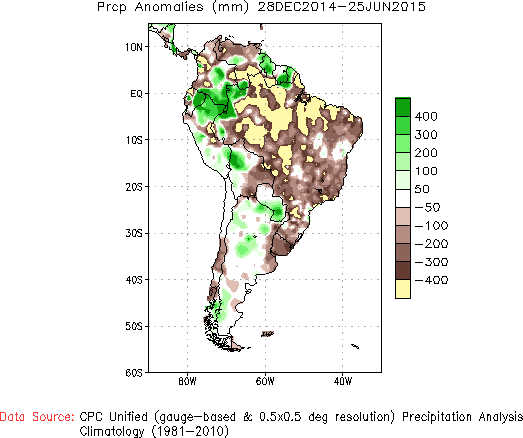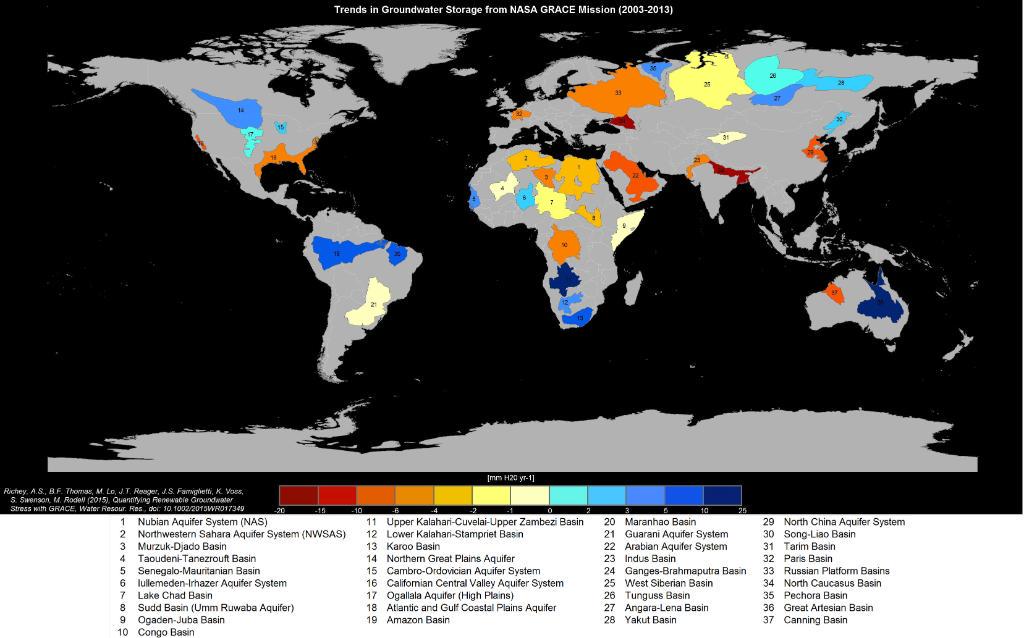Regardless if this is due to Climate Change from man-made causes or a natural earth cycle, we should all be concerned.
Lets start in our own back yard:
Even though, we've see measurable rain in some areas we are still running a deficit.
Since the start of 2015, Miami-Dade & Broward are showing a deficit between 11 and 15 inches.
The Keys are also in need of rain, but so far you're in the tolerable phase.
In California:
- Of course, the most talked about drought in the USA is in California. This crisis has created a unique situation. The City of Los Angeles is offering cash to growers in nearby Sacramento for their water. Over 37 billion gallons of water could be sold to L.A. for about $71 million.
- But if rice growers sell their water to make money instead of growing rice, what will they grow?This could cause a food and economic crisis.
- California’s Central Valley Aquifer was in the
most trouble. It is being drained to irrigate farm fields.
SAN JOSE, CA - APRIL 03: Dry cracked earth is visible on the dry Guadalupe Creek on April 3, 2015 in San Jose, California. The state is now in its fourth year of drought.
Plus:
Also running a negative balance was the Atlantic and Gulf Coastal Plains aquifer, which stretches across the Gulf Coast and Florida. But three other aquifers in the middle of the country appeared to be in relatively good shape.
Our neighbors across the Caribbean are in dire shape as well. They are enduring the worst drought in at least five years, longer in some other areas.
If you think none of this impacts you, you may be in for a surprise. Right now South Florida is under year round water conservation measures, but these could be tightened if our drought does not break.
Plus, if you like coffee and tropical fruits, you may end up paying higher prices as well.
Dominican Republic:
- Is facing its worst drought in the last 20 years.
- Water resources expert Martin Melendez, says if they don't get water soon, “we will be dry in around 30 days.”
- Mango growers are producing less than half of the more than 100 varieties grown.
- There are also people living in Santo Domingo that haven’t had any water in the pipes for almost a month. ((This info is attributed to Janina Segura, who oversees the natural resources department in the Center for Agriculture and Forestry Development. She adds, “It’s been too dry for farmers to plant basic grains like black beans and export crops."))
- Almost 1.6 million residents are impacted by the lack of water.
- Twelve of the twenty-two rivers that supply reservoirs are at record lows.
- Almost 350-thousand customers get water every third day.
- The National Guard has also been deployed to help distribute water and control tempers.
- Since the start of the year San Juan has accumulated 16.87" (through Thursday July 16th). The average amount is 25.71". That's a deficit of 8.84"
- In western Jamaica, a brush fire fueled by dry conditions scorched hundreds of acres of the famed Blue Mountain coffee crop.
- They also turned off taps overnight in Kingston
- Shut off water during the day in the city of Portmore.
St. Lucia:
Has been especially impacted. Farmers say crops including coconuts, cashews and oranges are withering.
Cuba:
- Officials say 75% of the island is enduring a drought that has killed cattle and destroyed thousands of acres worth of crops. These include plantains, citrus, rice and beans.
- Recent heavy rains in some areas have alleviated the problem some, but all 200 government-run reservoirs are far below capacity.
South America:
Most of the continent is suffering major drought. The graphic showing areas in yellows, brown and white are all in one stage or another of dryness.Colombia:
- Some places have been dealing with water shortages for more than three years.
- The situation is complicated due to the fact that most of the water from depleted aquifers in the region now goes to industrial uses like irrigation-fed international farms or open pit mines. This leaves very little water left for residents and what supplies remain are often brackish and polluted.
Brazil:
- Is in its worst drought in 80 years!
- Has been struggling with its own severe drought that has drained reservoirs serving the metropolis of Sao Paulo.
- The reservoir that supplies half the city is just over 10 percent full.
- The government has begun rationing water, though haphazardly.
Bolivia:
The worst drought in the last 30 years has ignited more than 47,000 fires over the last few months, creating health problems among the population and affecting the nation’s air traffic.
The rest of the World:
According to Nasa, 1/3rd of Earth's largest groundwater basins are being rapidly depleted
In Australia:
- There is a good news bad news situation. The Canning Basin, the country’s western end, had the third-highest rate of depletion in the world.
- But the Great Artesian Basin to the east was among the healthiest.
- The difference, according to the NASA study, is likely attributable to heavy mining near the Canning Basin. Mining is a water-intensive activity.
North Korea:
- Says it has been hit by its worst drought in a century, resulting in extensive damage to agriculture.
- The official Korean Central News Agency said the drought has caused about 30 per cent of its rice paddies to dry up.
Part of this drought is due to the phenomenon known as "El Nino". It impacts most of the world's marine and atmospheric currents. This makes for dry conditions in typically wet areas and vise versa. It also keeps hurricane activity low in the Atlantic basin.
All this brings us to the bottom line. WE NEED TO CONSERVE. This is no longer a them issue, or an over-there problem, but a world wide situation. Log on to your county's web site for information on water conservation.
Click on this link for the entire NASA article:
NASA Drought Study



No comments:
Post a Comment